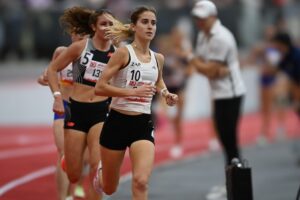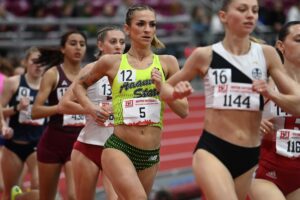
Like a lot of us, Molly Huddle logged on to YouTube on Saturday night to watch live as Elise Cranny won a fast women’s 10,000-meter race in San Juan Capistrano, Calif. Huddle’s takeaway: she has her work cut out for her if she’s going to make her third Olympic team this summer. The 36-year-old, who set the American 10,000 record of 30:13.17 in placing sixth at the 2016 Rio Olympics, also holds the U.S. record in the half marathon (1:07:25 from 2018). She phoned us on Sunday evening from her home in Scottsdale, Arizona.
Fast Women: So you watched last night?
Molly Huddle: I did watch last night, yes. I knew a lot of my competitors were going to be in it, so it was definitely important to watch and just see how it unfolded.
FW: Did you feel a pang of wishing you were in there mixing it up, running 74s and 75s?
MH: I really did. I wish I was about three weeks ahead of schedule and I would have felt comfortable enough doing [the meet]. I’m doing a 5K that I think is on the same track, on the 6th of March. I’m barely ready for that. But I really wish I could have been in [Saturday’s] race because they ran so even and so great for four miles, and it’s the same women you’re going to see at the Trials, so it would have been really good just to get that in. We just didn’t have our timing down because the meet popped up kind of late. And you don’t want to go if you’re not ready, because that’s worse for your confidence. But watching it I was like, ahhhh, I wish this was three weeks later, maybe a month later.
FW: So watching them click off those 5-minute 1600s… kind of a rough assignment for pacesetter Courtney Frerichs, no? She had to run that pace for 6K and then drop out!
MH: Yeah, definitely (laughs). She did good.
FW: Were you surprised to see Elise Cranny and Karissa Schweizer run those fast times? And how did it make you feel about your own prospects this summer?
MH: I wasn’t surprised. I mean obviously I knew that Karissa would run a good 10K after running such a good 5K last summer. [Note: Schweizer ran 14:26 in July to make her the second-fastest American ever at that distance.] Once I heard it was 5-minute pace, I figured they would cut down the last half to try to get under 31, so I wasn’t too surprised by that. And I’ve heard Elise is really good at the strength work, so I was kind of expecting a big one.
So yeah, the 10K is going to be a really deep event [at the Trials], because you have the marathoners coming back, and you have some 5K runners stepping up because I think the 10K is first on the schedule. I think we’re going to have some new American citizens, too, in the 10. So it’s suddenly become probably one of the harder distance events for the [Olympic] team. So I know I have my work cut out for me. It’s just a matter of getting my body cooperating and doing what it usually does.
FW: So is your body cooperating? You didn’t race much last year except for a couple very low-key meets on the East Coast, but now that we’re in the Olympic year, do you feel like you’re rounding into form, and the workouts that you used to do are still there for you?
MH: We’re hoping it gets there. We’ve only been working out hard workouts all of January, basically. And then coming into February. So my normal year, when we’re focusing on the track, we do a longer effort in March. I usually don’t race before that. So we’re actually kind of dropping down to something faster and shorter earlier than normal. Normally I don’t try a 5K until like May or so. The year is different. It feels like I’ve had good workouts, but then I’ve had workouts when I’m like, oh man, I really can tell I did a marathon buildup this year. It’s kind of just working all that out and you just gotta get on the track at the end of the day. You can’t really tell until you get into a race how things are going.
You gotta be ready. I have to be as fast as I ever was, which, is a tall order when you’re 37 and you’ve done marathon buildups. But it’s funny, it’s also my natural sweet spot, the 5K and the 10K on the track, so we’re hoping that helps.
FW: So in the Trials 10K, are you thinking that unlike in the past, where you could run 76s and then close with a 63 and win by a lot, you’re going to have to run 74s and 75s and still have company very late in the race and still need that big kick you’re known for?
MH: Oh, definitely. It’s definitely not going to be like the last two years where it’s kind of biding my time. So it’ll be interesting. Like I wish I were five years younger, because it would be pretty fun to mix it up and have that kind of depth up front. This will just be a really big challenge.
FW: Do you think that being 36 or 37 is the challenge? Or is it that you have several marathon buildups in your legs?
MH: I don’t think it’s being 37, I think it’s just my own running imbalances that have built up over the years. Because I’d say Sara Hall and Steph Bruce are running better than they’ve ever been, and they’re older than me. So it’s not age, it’s more the mileage that has beaten me up.
FW: Is the hope to make the team in the 10,000m and then not have to run the 5,000m at Trials?
MH: That’s the hope, I’m imagining I probably will have to do both, but the 10K is first, so that’s good, you get your best chance first.
FW: So is the Olympics your sole focus at this point? Or are you thinking about the marathon, and finally showing what you’re capable of at that distance based on what you’ve shown at the half?
MH: Yeah, I’m definitely picking my spots. Definitely the main focus is 100 percent to make the Olympic team in the 10K, but I totally could do a marathon in the fall after that, so that’s kind of what we’re looking towards. And the marathon will be there whether the Olympics are or not.
FW: Is it brutal to get back in track-speed shape, or do you enjoy the workouts?
MH: I do, I like the track workouts. I wish that’s all I had to do (laughs). Just not run mileage and just only run workouts. I like the workouts, they’re just more engaging, and it’s fun to go faster and focus like that.
FW: Does Kurt [Benninger, her husband] pace you for most workouts?
MH: I did quite a few by myself in January, when I was back in Providence. And then Emily [Sisson] and I lined up for one workout and then I did kind of tag Kurt in. And he hardly ran at all last year (laughs). So he’s really stepping up to dive back into workouts. He does a lap on, lap off for however long I need him to go, and somehow he can magically do it, as long as he gets a little bit of a break. He’s sore the next day, but he’s been doing it.
FW: Does your 30:13 seem even more incredible to you now with four and a half years of perspective? I mean, Karissa Schweizer ran 14:26 for 5,000, and the 10K time she ran last night was more than 30 seconds off what you did in Rio.
MH: It’s weird, because I thought Shalane’s [30:22] was so fast and that I could never run that fast. And then once I did it, I was like, actually, I think we just don’t run the 10K enough. We really just have Stanford, and then sometimes USAs or Worlds is tactical, so if it was a Diamond League event, the depth chart of the women’s 10K and men’s 10K would be a lot deeper. So I wouldn’t be surprised if that record goes down, to be honest, although when I’m doing workouts now I’m like, how did I ever do that? I do think, especially as some of the 1500m women are stepping up to the 10, for sure we’re going to see a lot more depth at the sub-31 level.
FW: Do you think you still have a low 30:00 in you at this point?
MH: I think so. I mean, in our buildup to the 2019 London Marathon, at Stanford, I ran 30:57 with Emily Sisson, and that was definitely not an ideal buildup, because I had a little bit of a niggle coming into that. And even in Doha, I kind of led my pack at 31-flat for the whole race, so I see how I can lop off 20 seconds, maybe 30 seconds, and get back into that shape.
FW: I heard you did a 4K time trial this weekend. Who was your pacer, and how did it go?
MH: My pacer was Henry Sterling, who my husband coaches. It was kind of part of his workout. And it was not good. But I can count on two fingers how many good time trials I’ve had in my entire life. We put the time out there to target, but the point is more to hurt, and I almost never actually hit the time. The point was just to get that out of the way before the race. So in that way, it was definitely mission accomplished, but it was not as fast as we wanted to go.
FW: Did you start out at the projected pace and fall off? Or from the beginning was it like, that pace is not happening?
MH: We were supposed to wind it up and I just never really did, because it just felt rough. But I hate time trials, I’m someone who would rather race.
FW: I saw that you scratched from the 5,000m at the Trials of Miles Texas Qualifier meet next weekend. Is that because you’re a little behind where you wanted to be?
MH: No, it was just as we got more information, we realized the pace was going to be 15-flat or under, and I wanted more of a 15:10 kind of race. We originally thought it would be more like Olympic standard times (note: the Olympic standard for the women’s 5,000 meters is 15:10.00). And the meet was getting kind of big, which was a little bit of a Covid concern. Once we heard about the other meet, we decided maybe that would be a better fit.





